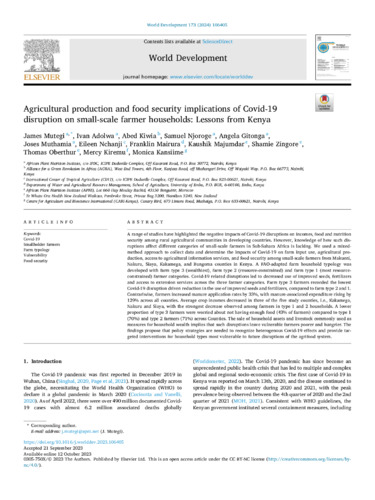Agricultural production and food security implications of Covid-19 disruption on small-scale farmer households: Lessons from Kenya
A range of studies have highlighted the negative impacts of Covid-19 disruptions on incomes, food and nutrition security among rural agricultural communities in developing countries. However, knowledge of how such disruptions affect different categories of small-scale farmers in Sub-Sahara Africa is lacking. We used a mixed-method approach to collect data and determine the impacts of Covid-19 on farm input use, agricultural production, access to agricultural information services, and food security among small-scale farmers from Makueni, Nakuru, Siaya, Kakamega, and Bungoma counties in Kenya. A FAO-adapted farm household typology was developed with farm type 3 (wealthiest), farm type 2 (resource-constrained) and farm type 1 (most resource-constrained) farmer categories. Covid-19 related disruptions led to decreased use of improved seeds, fertilizers and access to extension services across the three farmer categories. Farm type 3 farmers recorded the lowest Covid-19 disruption driven reduction in the use of improved seeds and fertilizers, compared to farm type 2 and 1. Contrariwise, farmers increased manure application rates by 33%, with manure-associated expenditure rising by 129% across all counties. Average crop incomes decreased in three of the five study counties, i.e., Kakamega, Nakuru and Siaya, with the strongest decrease observed among farmers in type 1 and 2 households. A lower proportion of type 3 farmers were worried about not having enough food (43% of farmers) compared to type 1 (70%) and type 2 farmers (71%) across Counties. The sale of household assets and livestock commonly used as measures for household wealth implies that such disruptions leave vulnerable farmers poorer and hungrier. The findings propose that policy strategies are needed to recognize heterogenous Covid-19 effects and provide targeted interventions for household types most vulnerable to future disruptions of the agrifood system.

